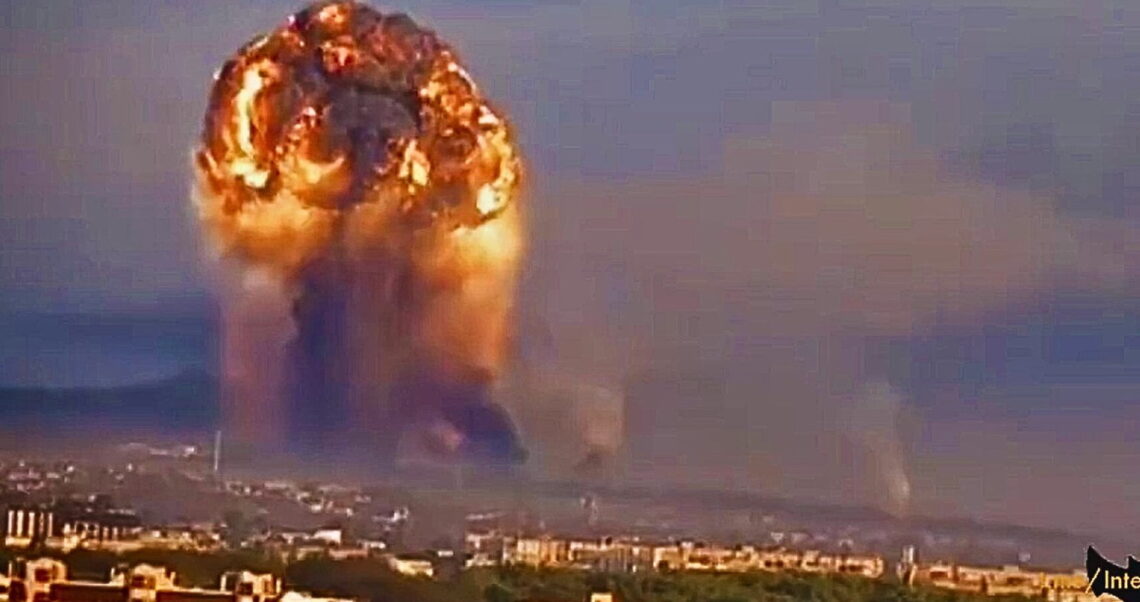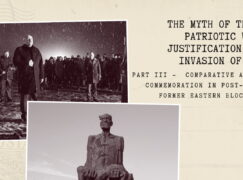The explosion in Khmelnytskyi is a topic that has been circulating on social media for several days. Numerous recordings show a huge explosion and a cloud resembling a mushroom cloud. Many Internet users claim that depleted uranium munitions for Challenger 2 tanks were stored in warehouses there. This would constitute a huge success of the Russian airstrike. However, there is no evidence of this, and the information circulating on social media should be considered rumours.

Lack of evidence
More about our rating system:The information about the massive explosion in Khmelnytskyi, along with dramatic recordings and photos, has been shared by dozens of social media accounts. Many of them claimed that the warehouse stored tank shells with depleted uranium donated by the British. Therefore, it was claimed that the explosion created a radioactive cloud that poses a threat not only to Ukraine but also to neighbouring countries, including Poland. The overwhelming majority of users sharing these narratives are people who have long been engaged in reproducing information in line with the Kremlin’s propaganda.
This information was shared i.a. by Piotr Panasiuk, Balli Marzec and Artur Kalbarczyk. In addition to them, numerous social media accounts of a more or less anonymous nature also willingly reproduced these narratives. Among them were Twitter users (here or here) and Facebook (here or here). Along with this information, there were also rumours about an increase in radiation in Poland, primarily in Lublin. We dealt with this fake news in one of our recent articles.
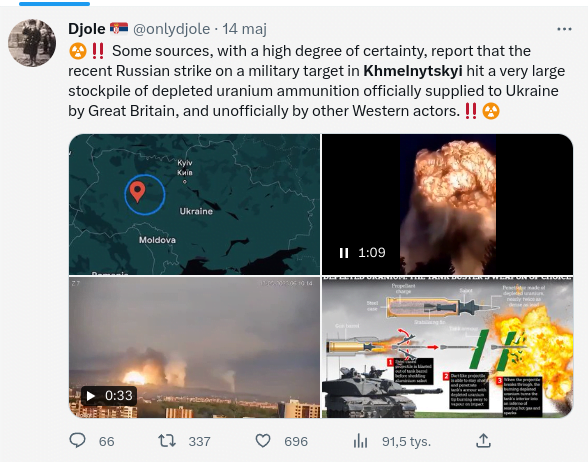
Explosion in Khmelnytskyi
The attack on the city of Khmelnytskyi took place in the morning of 13 May, 2023. For this purpose, the Russians used means of aircraft warfare, most likely Iranian-made Shahed 136 drones. The impact triggered at least two huge explosions that created a cloud that resembled a mushroom cloud hundreds of meters high.
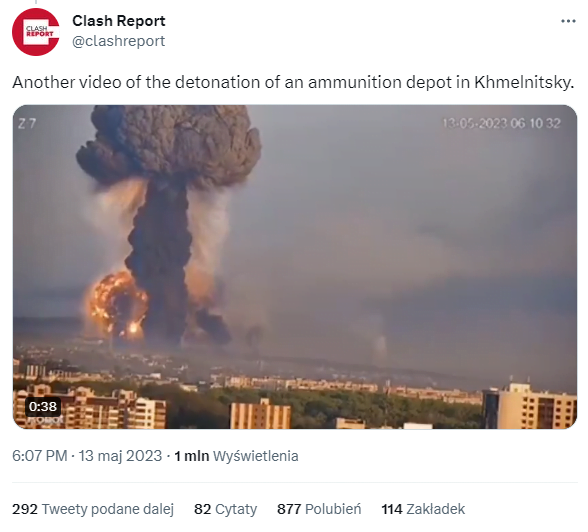
Such a large explosion could only be caused by large amounts of explosives and flammable materials stored in one place. As it turns out, the facility attacked was an ammunition and fuel depot from the Soviet era. The geolocation of this place has been confirmed by specialists from GeoConfirmed.
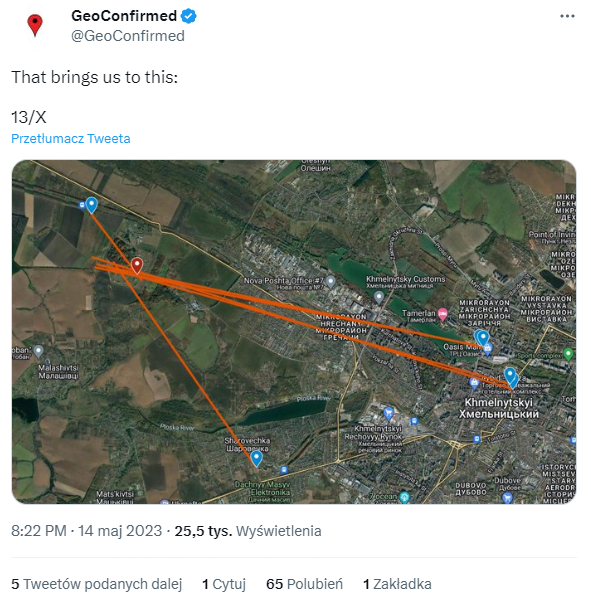
Based on the analysis of several recordings, the following coordinates were selected: 49°27’05.9″ N and 26°52’34.1″ E. With the use of Google Maps, it is easy to verify that there is indeed a military warehouse storing explosives there. This is evidenced, among others, by the earth embankments surrounding the buildings, which are supposed to weaken the shockwave of a possible explosion and direct its force upwards.
After a short search, you can easily find information about an ammunition depot located a few kilometres from the city of Khmelnytskyi. As it turns out, the facility has been a cause of great concern for locals already in 2011. They did it also in 2017, after an explosion in a post-Soviet ammunition depot in the neighbouring Vinnytsia Oblast. It was also confirmed at that time that mainly decommissioned aircraft ammunition was stored there. The final confirmation of the location of the hit object is satellite photos from 15 May, which show the almost complete destruction of the facility.
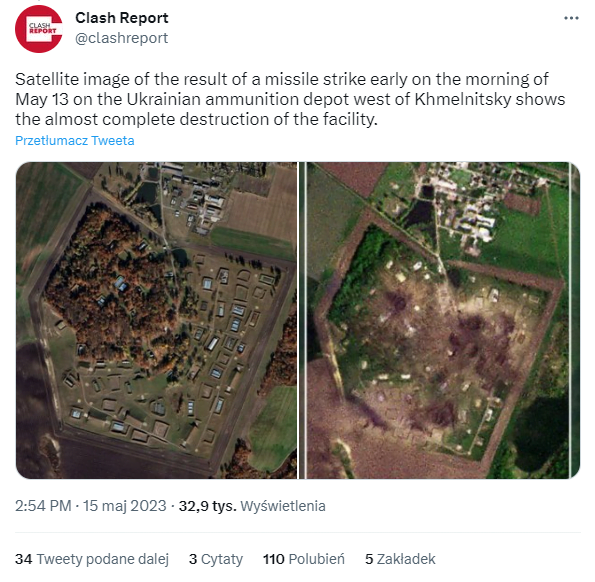
What was in the warehouse
It seems highly unlikely that the Ukrainian military would keep depleted uranium munitions in warehouses, the location of which was publicly known years before the war. Everything indicates that this depot stored mainly old aerial bombs and other war materials from the Soviet era. The vast majority of them were intended for disposal, and the process was gradually carried out between 2012 and 2022. However, due to a lack of funds, it had not been completed before the outbreak of the war.
In fact, it is not possible to say unequivocally what was in the warehouse at the time of the attack. Perhaps current war materials were stored in some of the buildings. However, such information could not be confirmed by pro-Russian social media accounts, which do not provide any evidence of this state of affairs. The alleged increase in radiation, which would confirm the presence of depleted uranium munitions, should be regarded as false. More on this below.
The Russians have been carrying out attacks on sensitive points in Ukraine for several weeks. On 30 April 2023, missiles struck depots in Pavlohrad with solid rocket fuel from intercontinental ballistic missiles intended for recycling. They were therefore not critical supplies for the Ukrainian war effort. There are many indications that the campaign of air strikes on old ammunition and fuel depots is carried out primarily for propaganda purposes. Thanks to them, the Kremlin’s apparatus of influence has spectacular visual materials to prove the effectiveness of Russian actions in Ukraine. However, in most cases, destroyed materials are of low value to the Ukrainian army, and the losses mainly affect the local civilian population.
Explosion in Khmelnytskyi — the next Chornobyl?
Many pro-Russian social media accounts are trying to compare this event to the Chornobyl explosion. Allegedly, the increase in radiation in the city is very large. Khmelnytskyi’s authorities, as well as scientists from the local university, denied that there was an increase in radioactivity in the city and its vicinity. No measuring instruments showed alarming readings.
The radioactive cloud was also supposed to reach Poland. In Lublin, an increased level of bismuth in the air was recorded. This was immediately used by pro-Kremlin social media accounts. However, as we pointed out in our article, this is a completely natural phenomenon that poses absolutely no threat to the inhabitants of Poland.
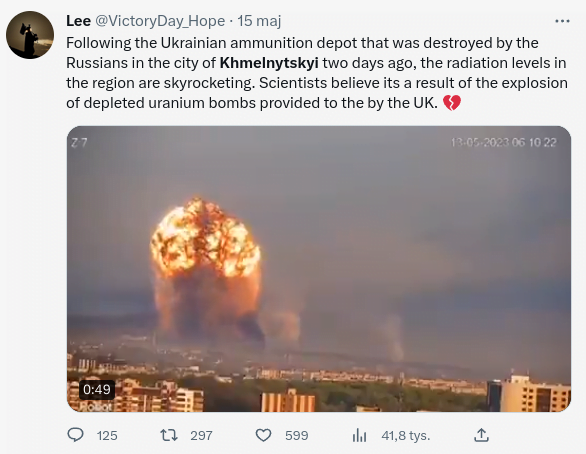
Nikolai Patrushev, secretary of the Security Council of the Russian Federation, began proactively spreading panic over the alleged radiation threat (after the publication of our previous text). Without providing any evidence, he claimed that a radioactive cloud was moving over Poland and Western Europe. It was supposed to be the result of blowing up several ammunition depots with depleted uranium.

The above narratives are in line with the narratives of the Kremlin, which, since the announcement of the transfer of missiles of this type to Ukraine, has presented this fact as an escalation and use of nuclear weapons against Russia. As we explain below, this is absolute nonsense intended only to create panic and uncertainty among the Western public. In addition, there are many indications that the Russians themselves have been using such missiles, and the whole story was created purely for propaganda purposes.
On the very same day, the National Atomic Energy Agency denied the rumours spread by Patrushev, re-assuring that there were no worrying readings of radiation levels. As of 21 May 2023, the situation remained unchanged.
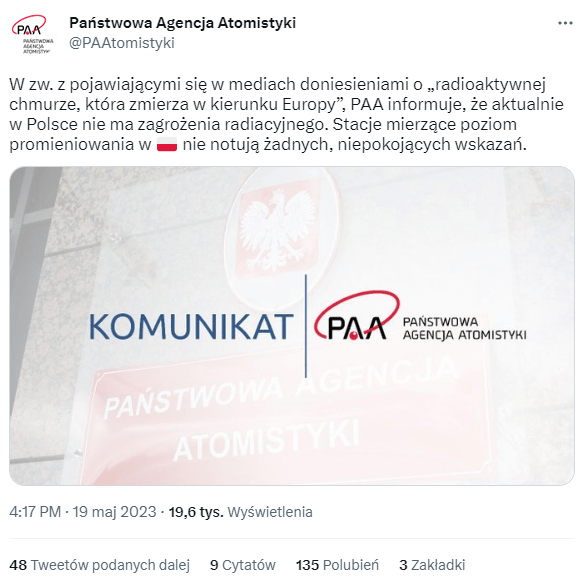
Ammunition containing depleted uranium
Depleted uranium is a by-product of enriched uranium production. The latter is used, among others, in nuclear reactors. Depleted uranium, on the other hand, is much less radioactive compared to natural uranium. It is also extremely dense and hard. These properties make it a perfect choice for military purposes.
Armour-piercing ammunition (AP) containing depleted uranium has a characteristic design. It is a sub-calibre ammunition that comprises a sabot and a core. The sabot is a supportive device used for providing high muzzle velocity of the core (also known as a penetrator). After leaving the muzzle, the sabot typically separates from the core in flight. Penetrators made of depleted uranium (or other materials, such as tungsten) are long and thin. While penetrating the armour, the projectile undergoes adiabatic shear banding (self-sharpening), which significantly increases its penetration capabilities and combat effectiveness.
Ammunition radioactivity
As already mentioned, the radioactivity of depleted uranium is relatively low compared to its natural form. This means that the cores of armour-piercing shells do not pose a large-scale radiation threat. The most dangerous is direct contact through inhalation or consumption. According to the United Nations and the International Atomic Energy Agency, there are no indications that the use of munitions with depleted uranium has any significant radiation impact on the local community or nature. It is worth remembering that uranium is a heavy metal and, as such, it has toxic properties (like many other substances used in the defence industry). In this case, however, the very fact of warfare and the use of a large amount of toxic and dangerous substances will have a negative impact on the environment, regardless of whether or not depleted uranium ammunition is used.
Therefore, contrary to the narratives spread by pro-Russian social media accounts, there is no evidence that there has been an increase in radiation in Khmelnytskyi. The ammunition there has nothing to do with nuclear weapons. It poses no greater threat than many other conventional war materials.
Summary
Russian propaganda is once again actively trying to spread panic in Poland and European countries. These narratives are very eagerly re-shared by numerous social media accounts. At the moment, there is no evidence that warehouses in Khmelnytskyi stored ammunition with depleted uranium. No increase in radiation was observed either in the Ukrainian city or in Poland. What is more, depleted uranium munitions do not pose an additional large-scale radiation hazard.
Sources
The Insider: https://theins.ru/news/261716
Segodnya.ua: https://ukraine.segodnya.ua/amp-ukraine/Ukraina-utiliziruet-boepripasy-CHernomorskogo-flota-RF-380092.html
Rzeczpospolita: https://www.rp.pl/konflikty-zbrojne/art38497611-patruszew-radioaktywna-chmura-zmierza-w-strone-europy-wykrywaja-ja-w-polsce
Międzynarodowa Agencja Energii Atomowej: https://www.iaea.org/topics/spent-fuel-management/depleted-uranium
